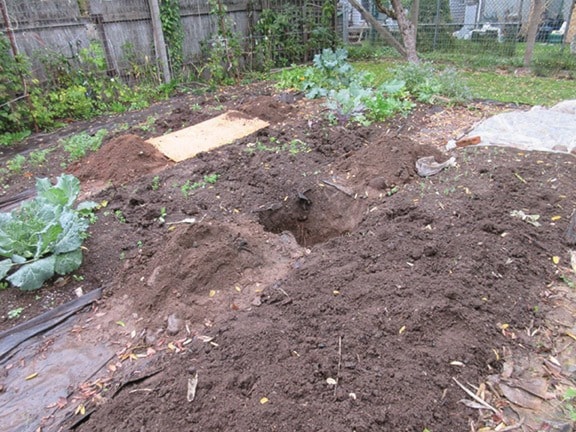Garlic may be the easiest crop to grow. You plant it any time in October and it’s ready next July without a whole lot of trouble on the gardener’s part.
Here’s one method: if this is a new bed, measure off its dimensions and dig along the perimeter with a shovel just to delineate the garden. Push down into the soil as far down as the shovel will go and pop any hardpan that might be there. Pull out the shovel without turning over the soil. Then go over the whole bed like this every few inches, leaving the soil oriented the same way.
Don’t turn the soil over as recent studies have shown that this damages the soil structure and plants do not grow as well. You have a few options now: you can cover the bed with a) a one-inch layer of shredded leaves (although I have read that leaves are acidic, I have never noticed any deleterious effect on my gardens), or b) a layer of newspapers which you shred or poke holes all over for drainage.
Cover the leaves or newspapers with a four-inch layer of either compost or topsoil or a mix of both to which you can add peat moss, available in big bales for $9.99 at Home Hardware. Sprinkle with fertilizer — I use Steve Solomon’s mix which is four parts seed meal, one-half part lime, one-half part phosphate rock and one-half part kelp meal, applied at the rate of one litre for every 100 square feet. Store-bought garlic should grow well as long as it hasn’t been irradiated, but you’re better off buying seed garlic from a supplier.
Mix the fertilizer in a bit with a hoe or rake, soak the bed thoroughly and you can plant right away since the leaves and newspaper rot pretty quickly in our winter rains. Separate the cloves from the garlic bulb gently since you don’t want to bruise or break any. If they do break they’ll probably rot in the ground so throw them out. If you find a mouldy clove, don’t use the entire bulb since this mould can spread throughout the bed and rot all your garlic. Put it in a plastic bag to return to the supplier and wash your hands.
Push each clove from sound bulbs into the soil three to four inches deep, orienting the flat (root) side down and the pointy (stem) side up. If you plant it the other way around the garlic will expend so much energy re-orienting itself that the resulting bulb will be smaller. Plant them six inches apart in rows that are eight inches apart. No watering, ever, and that’s it! You might want to cover it temporarily with mesh or spun cloth cover like Remay to keep out varmints like the neighbour’s cat.
I was feeling smug because I got on top of things this year and planted my garlic two weeks ago. How was I to know that a sewer line running right under the middle of the garden had broken and the CVRD crew had to come and dig it up? These fine gentlemen gave me time to move my garlic and other winter vegetables so they could come in with a small backhoe and dig a trench across the backyard to replace the broken clay pipe. The garlic roots were two and three inches long already and I expect they’ll survive the transplant. No wonder they were so voluptuous!
